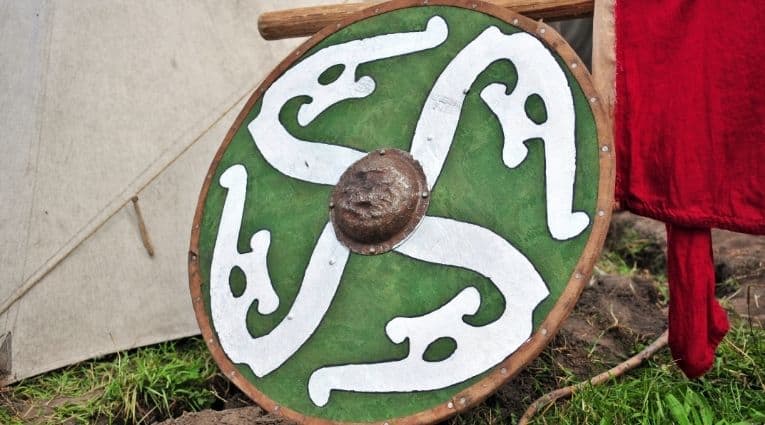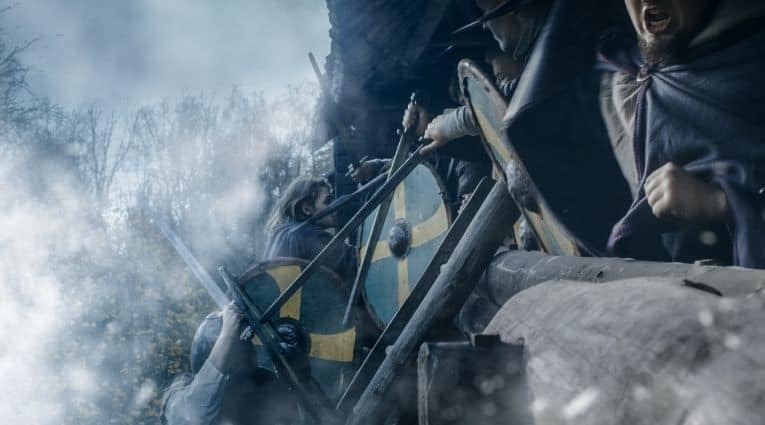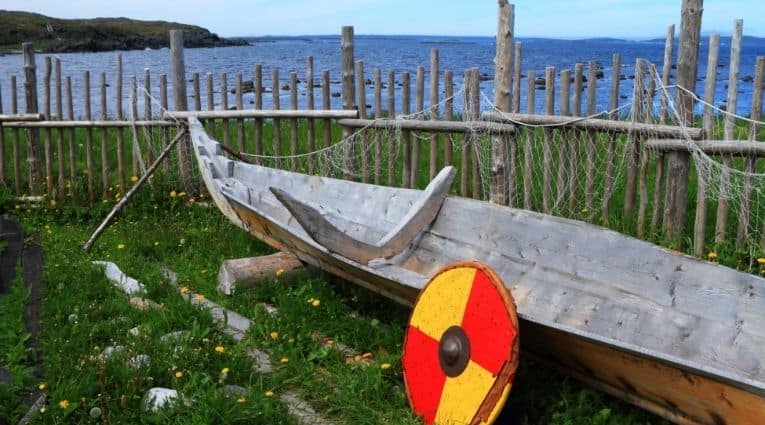The Vikings were perhaps the most feared fighting force of their era, and with good reason.
Their longships and nautical expertise put any shoreline within their reach, and once they disembarked, Viking warriors outclassed virtually any armies that stood in their way.
While their prowess with swords and axes is indisputable, the Vikings owe much of their military success to the effectiveness of their shields.
The Viking shield is round because this shape is agile and easy to maneuver while being gripped from its center.
Wood is a lighter and cheaper material than metal. Painting the shield coats the grain in the wood planks to prevent splitting while acting as a sealant against moisture.
While there was without question great brutality in their methods, the Vikings were also highly skilled in their combat techniques and developed effective fighting strategies.

Armor, chain mail, and helmets were premium items that may have been worn exclusively by noblemen and chieftains who could afford their high cost.
But a shield was indispensable, and every Viking warrior went to battle armed with one.
Ever wonder what the Vikings looked like? See Did the Vikings Wear Dreadlocks? to learn more.
Vikings Preferred Their Shields to Be Light and Maneuverable
Although they were master strategists and certainly would have utilized military formations in the field of battle, Viking warriors were at their best when fighting in close quarters, as that was when they could use their superior skills and combat instincts.
When it came to defending themselves against enemies’ weapons, a light, wooden shield served them best while doubling as a weapon itself when needed.

The Viking shield was circular like a giant disc and typically measured 80 to 90 cm (32 to 36 inches) across and weighed around 7 kilograms (15 pounds).
Since no centralized armory issued combat gear, most Viking warriors would have been responsible for crafting their shields.
Presumably, specific shield dimensions would have correlated to the stature of its owner. [1]
The Vikings were religious people. Before converting to Christianity, they adhered to Norse Mythology. See Norse Mythology vs Christianity to learn more.
Wood was the preferred material for constructing Viking shields as it was a cheap and plentiful resource.
Unlike iron, which was expensive to begin with, a wooden shield was lighter and easier to handle for defensive and offensive maneuvers.
Although Viking shields would not be able (nor expected) to withstand a direct, head-on strike from a sword, axe, or spear, they were designed to deflect and lessen the impact of weapon blows.

Anatomy of a Viking Shield
The effectiveness of the Viking shield can be attributed to the simplicity of its design.
Viking warriors held their round shields with a single hand in the center of the shield, which meant equal amounts of coverage in all directions from the hand on out.
With a roughly three-foot diameter, this would provide coverage from shoulder to knee for most Vikings.
When it comes to Norse Mythology many people know about Odin and Thor. But what about the dwarves? See Meet the Dwarves of Norse Mythology to learn more.
Viking shields consisted of the following essential parts:
- The board, or shield body – Consisted of 7 to 8 wooden planks split along the grain from native trees (fir, pine, and linden). The planks were laid alongside one another and either glued or affixed to each other. Viking shields were thicker in the center (8 to 10 mm; roughly one-quarter of an inch) and thinned out toward the edges (5 to 6 mm).
- The boss – Viking shields were held by one hand and not strapped to the forearm like other shields of the Middle Ages. A bar that formed the handle ran across the middle of the shield, and to allow it to be gripped appropriately, a hole was cut in the center of the shield.
A bowl-shaped metal covering known as a boss was placed over the center hole outside the shield to protect the shield-bearing hand.

Bosses were typically made of iron, and some were designed with an overhanging flange that has been theorized to enable the shield-bearer to trap enemy blades and wrench them out of a combatant’s hands.
- Structural support – To give the shield rigidity and strength, a rim encircled the shield. Sometimes animal skins were used as an outer cover (they would shrink after being applied, thus tightening the planks against each other).
The shields’ round, wooden construction provided vital defensive and offensive advantages which Viking warriors utilized to their fullest:
- The shield could easily be transferred from one hand to the other in a moment of need on the battlefield.
- With its large surface area, a Viking shield was not designed to absorb the impact of an enemy’s blow. Instead, it redistributed and dispersed that force throughout the shield and the shield-bearer’s body, reducing shock and injury.
- Viking shields were not used passively and at the expense of offense but in conjunction with weapons. Held to the side in an active, athletic stance, the shield provided protection while not hindering the free movement of the Viking warrior’s weapon hand.
- Although the planks were relatively thin, the shield could seize and bind weapon edges within the wood fibers, allowing Viking soldiers to strike back at a momentarily defenseless enemy soldier. Experienced warriors could wrestle a stuck weapon away from an enemy soldier or even break a blade or snap a handle in two.
- The shield itself could be used as a weapon, either swung edgewise at an opponent’s head or upper body or held out in front with a jabbing motion to crowd an enemy soldier and reduce the amount of free space to swing or maneuver their weapon. In moments of desperation, the shield could even be used to charge at an opponent and knock them off balance.
- Viking shields also had a leather strap that allowed them to be slung over warriors’ shoulders on their backs, freeing up the shield-bearing hand to swing a sword two-handed or wield a second-weapon like an axe or a spear. [2]

Here Is Why the Vikings Painted Their Shields
Although very few Viking era shields have been recovered intact, traces of paint indicate that shields may have been painted with colors like black, blue, red, white, and yellow.
Some were adorned with patterns like spirals and pinwheels or other decorations, either to indicate a particular allegiance or seek certain Norse gods’ protection or blessing. [3]
There are even indications that the color displayed on a shield had a symbolic meaning; for instance, a white-colored shield may have indicated peaceful, non-combat intentions while red was an unmistakable harbinger of battle. [4]
Perhaps most importantly, and more practically, Viking shields were likely painted to conceal the direction of the wood grain from an enemy soldier, as a direct strike along the grain with a sharp-edged weapon like a sword or axe would surely have split the thin wooden planks cleanly and rendered the shield useless.
Since Viking shields were made of wood, they also needed to be protected from moisture.
If the wood succumbed to moisture, it could potentially rot and weaken.
Additionally, the wooden planks could absorb water and become significantly heavier and, subsequently, more challenging to maneuver and exhausting to wield for the length of a battle. [5]

Vikings Did Not Hide Behind Their Shields
Contrary to depictions on television and the big screen, it is likely that Viking warriors did not stand shoulder to shoulder to form a wall with their shield to hide behind.
Given the relatively thin and light construction of their shields, such a strategy would certainly have been unsuccessful in protecting them from flying arrows and enemy blows.
And more importantly, hiding behind a shield was not the Viking way. [6]
Conclusion
For several centuries, the Vikings were feared throughout Europe, and their military success resulted from the swords they wielded and their shields.
References:
[1] https://www.warriorsandlegends.com/viking-warriors/viking-warrior-shields/
[2] https://www.vikingrune.com/2012/01/viking-shield/
[4] https://www.vikings.com/news/the-truth-behind-vikings-shields-18274816
[5] https://sonsofvikings.com/blogs/history/the-viking-shield-a-historic-look
